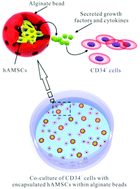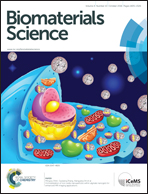Encapsulated feeder cells within alginate beads for ex vivo expansion of cord blood-derived CD34+ cells†
Abstract
A co-culture system based on encapsulated feeder cells within alginate beads was developed through optimizing the detailed aspects of the cell culture system to expand CD34-positive (CD34+) cells ex vivo. Mesenchymal stem cells isolated from different sources (human amniotic (hAMSCs) and umbilical cord (UCMSCs)), and human fibroblast cells (HFs) have been respectively chosen as feeder cells and the results showed that the hAMSCs were superior to UCMSCs and HFs in conventional two-dimensional (2D) co-cultures regarding the promotion of total nucleated cell (TNCs) expansion and the maintenance of the CD34+ phenotype. Alginate beads were employed to limit the growth of hAMSCs, which could effectively restrict the proliferation of the encapsulated hAMSCs, while the cell viability of hAMSCs was still highly maintained. Intriguingly, only a few hAMSCs migrated out of the alginate beads, whereas secreted growth factors and cytokines could be easily released. Furthermore, the alginate beads supported CD34+ cells/hAMSCs 2D indirect co-culture exhibited increased TNCs expansion, higher percentages of CD34+ and CD34+CD38− cells, and better cell vitality when compared to the 2D co-culture. Therefore, the co-culture system based on encapsulated hAMSCs within alginate beads can effectively promote CD34+ cells to expand ex vivo.


 Please wait while we load your content...
Please wait while we load your content...